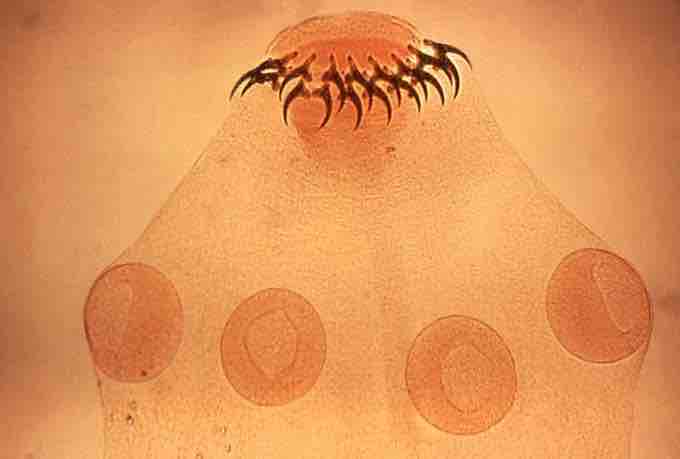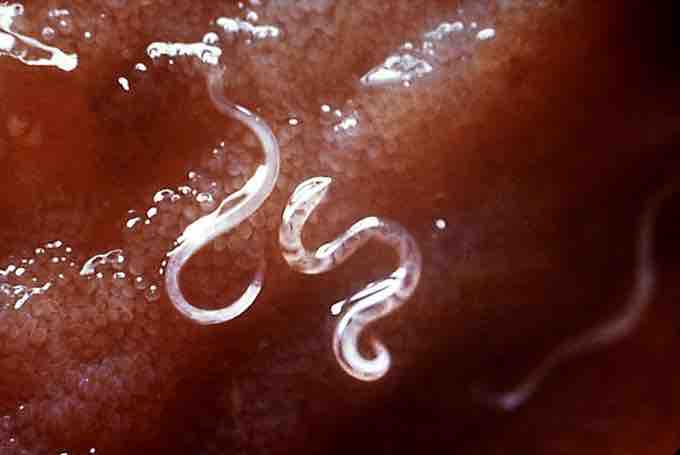Parasitic worms that inhabit the intestinal tract (blood, tissue and organs) of humans are referred to as helminths. They receive nourishment and protection by living within the host where they cause disease. The parasitic intestinal helminths can be divided into three groups which include Nematodes (roundworms), Cestodes (tapeworms), and Trematodes (flukes). Helminths share numerous characteristics that contribute to their parasitic quality including the presence of attachment organs. These attachment organs include bothria (sucking grooves: Cestodes or tapeworms, which may also have a rostellum (crown of thorns with hooks); Old World Hookworms: cutting teeth; New World Hookworms: cutting plate. These attachment organs allow these particular helminths to reside within their human host. It should be noted, however, that blood and tissue roundworms (Nematodes) exist that will not be discussed in this section.

Suckers on Taenia solium
A micrograph showing the morphology of a Taenia solium tapeworm scolex with its four suckers, and two rows of hooks.
The three commonly studied and well-known groups include the intestinal Nematodes (round worms), tapeworms (Cestodes), and blood, tissue and organ flukes (Trematodes).
Intestinal helminths are commonly transmitted through fecally contaminated food and water and these parasites include Ascaris lumbricoides, Trichuris trichiura (whipworm), and Enterobius vermicularis (pin worm).
Hookworms include Ancylostoma duodenale and Necator americanus, whose larvae penetrate the skin after their ova have been passed in human feces. These soil-transmitted helminths are associated with climates that are warm and moist and where sanitation and hygiene are poor. The eggs are passed in the feces of the infected individual, the larvae hatch, contaminate the soil, and can penetrate the skin when contact is made.
Ascaris lumbricoides, the cause of Ascariasis, is a type of soil transmitted helminth. Ascaris, the largest roundworm, lives in the intestine and the eggs are passed in the feces of the infected person. Ascariasis is caused by ingestion of eggs from food and water contaminated with feces from humans infected with Ascaris, and ingestion allows for continuation of the life cycle. Ascariasis may not be symptomatic, but may become symptomatic or fatal if intestinal blockage occurs without surgical intervention.
Hookworms, another type of soil-transmitted helminth, reside in the small intestine and eggs are passed in the feces of the infected individual. The eggs will mature and hatch in the soil and the immature worms (larvae) will penetrate the skin of humans if contact is made. The hookworm is transmitted by exposing bare skin to contaminated soil .

Hookworms
An image of a hookworm attached to intestinal mucosa.
Whipworms (Trichuris trichiura), a type of soil-transmitted helminth, resides in the large intestine and eggs are passed in the feces of the infected individuals. The eggs will mature into an infective form in the soil and transmission occurs by ingestion of eggs in fecally contaminated food and water. Individuals with whipworm may have light or heavy infections. Light infections are usually not significantly symptomatic. However, heavy symptoms include frequent, painful passage of stool that contains mucus, water, and blood.
This summary does not contain an exhaustive compilation of all human parasitic nematodes, but merely a representation of several species.